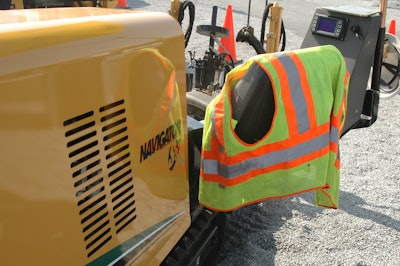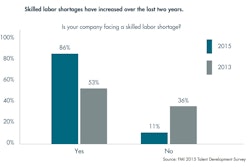
The National Association of Home Builders estimates that in the U.S., there are currently approximately 200,000 construction job openings waiting to be filled, which is an 81% increase over the past two years.1 BathMasters founder Greg Norman sees first-hand how this labor shortage is plaguing the construction industry.
Between 2004 and 2014, there were 837,800 jobs lost throughout the U.S. construction industry.2 Across the nation, there are currently 17% fewer people working in construction than when the market was at its peak.1 “The construction industry took a really hard blow during the last recession, and now that the need is there, experienced construction workers are harder than ever to find,” Norman noted. “Many workers left the construction field altogether, and now we’re feeling the impact, as there aren’t as many seasoned professionals remaining to mentor the new generation.”
The construction industry is struggling with a higher demand and a graying labor pool. In 1985, the average age of construction workers was 36 years old. This average jumped to 40.4 years old by 2008, and it continues to rise. In fact, construction workers tend to stop working at an earlier age than do workers in other sectors, which has further reduced the number of experienced workers. There are also a significant number of “baby boomers” in the industry, which means that the number of experienced workers will only continue to dwindle over the next 10 years.3
Due to the physical demands of this type of work, employed construction workers should be healthier than the general population. However, for many, this is not the case, with a higher incidence of overweight construction workers, and many being smokers — putting them in the danger zone for heart disease, diabetes, lung cancer and other health problems.3
Another issue plaguing the construction industry is the dangers faced by workers. At least 10% of workers leave the industry due to injury or illness. As a result of constant handling of materials, the need for awkward postures, and the highly physical demands of such work, construction workers may also develop musculoskeletal disorders such as painful shoulder or lower back problems. These types of conditions and health issues only contribute to the growing number of workers leaving the construction field.3 When taking into consideration the age of the workers, as well as the potential for illness and injury, it becomes clear that the lack of experienced professionals in the construction world has reached epidemic proportions.
As the industry’s demand continues to rise, it is estimated that real output in the construction sector will increase by about 2.8% annually, reaching slightly below $1.4 billion by 2024. This makes construction the fastest growing industry of all the goods-producing sectors, and will even outpace economic growth as a whole. Projections also suggest that the construction industry will have the largest industry increase for employment by adding approximately 790,400 jobs by 2024.2
“The resurgence of the construction industry is reliant upon experienced contractors remaining healthy, and teaching the next generation of construction workers the ins and outs of the field,” Norman commented. “As someone who grew up learning about the construction industry from my elders (bathmastersflorida.com/meet-the-masters/), I understand the tremendous importance of learning from seasoned construction professionals how to produce high-quality products that will stand the test of time.”
1 Reuters. “A Construction Worker Shortage Is Weighing on a Hot U.S. Housing Market.” A Construction Worker Shortage Weighs on a Hot U.S. Housing Market | Fortune.com. Fortune, 06 Sept. 2016. Web. 07 May 2017.
fortune.com/2016/09/06/housing-construction-worker-shortage/
2 ”Industry Employment and Output Projections to 2024: Monthly Labor Review.” U.S. Bureau of Labor Statistics. U.S. Bureau of Labor Statistics, Dec. 2015. Web. 05 May 2017.
bls.gov/opub/mlr/2015/article/industry-employment-and-output-projections-to-2024.htm
3 Laura WelchMar. “The Aging Worker in the U.S. Construction Industry.” Occupational Health & Safety. N.p., 01 Mar. 2010. Web. 05 May 2017.
ohsonline.com/articles/2010/03/01/the-aging-worker.aspx

















